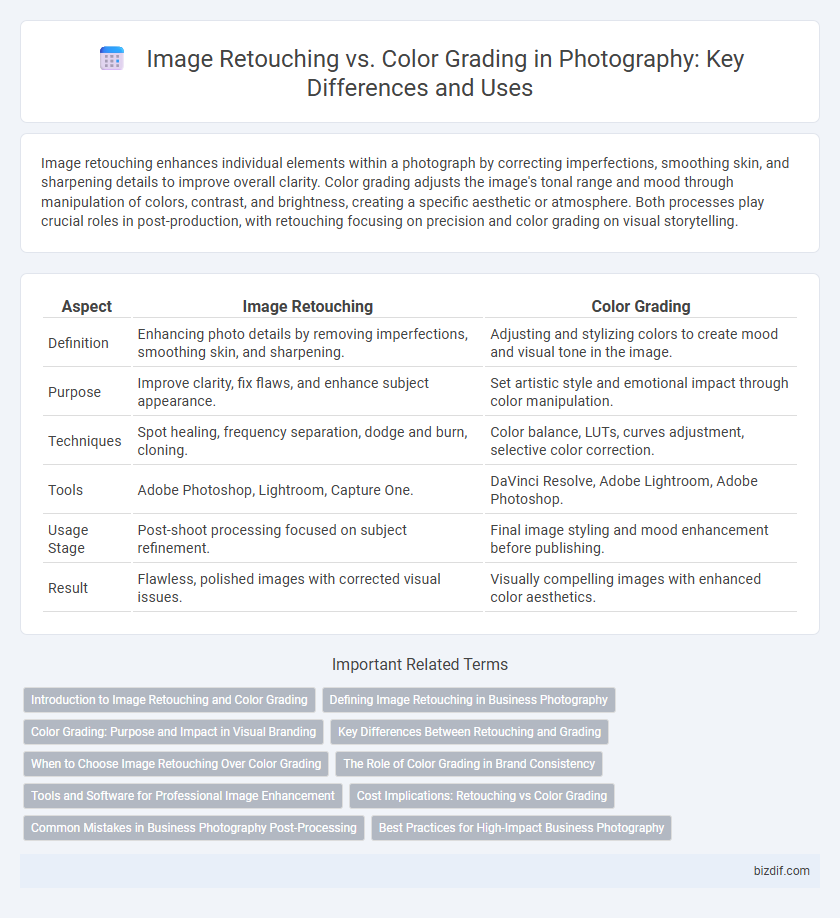Image retouching enhances individual elements within a photograph by correcting imperfections, smoothing skin, and sharpening details to improve overall clarity. Color grading adjusts the image's tonal range and mood through manipulation of colors, contrast, and brightness, creating a specific aesthetic or atmosphere. Both processes play crucial roles in post-production, with retouching focusing on precision and color grading on visual storytelling.
Table of Comparison
| Aspect | Image Retouching | Color Grading |
|---|---|---|
| Definition | Enhancing photo details by removing imperfections, smoothing skin, and sharpening. | Adjusting and stylizing colors to create mood and visual tone in the image. |
| Purpose | Improve clarity, fix flaws, and enhance subject appearance. | Set artistic style and emotional impact through color manipulation. |
| Techniques | Spot healing, frequency separation, dodge and burn, cloning. | Color balance, LUTs, curves adjustment, selective color correction. |
| Tools | Adobe Photoshop, Lightroom, Capture One. | DaVinci Resolve, Adobe Lightroom, Adobe Photoshop. |
| Usage Stage | Post-shoot processing focused on subject refinement. | Final image styling and mood enhancement before publishing. |
| Result | Flawless, polished images with corrected visual issues. | Visually compelling images with enhanced color aesthetics. |
Introduction to Image Retouching and Color Grading
Image retouching focuses on enhancing the photograph by correcting blemishes, adjusting exposure, and refining details to create a polished and flawless appearance. Color grading involves altering and enhancing the colors, tones, and mood of the image to evoke specific emotions and establish a distinct visual style. Both techniques are essential in modern photography workflows to achieve professional and impactful results.
Defining Image Retouching in Business Photography
Image retouching in business photography involves digitally enhancing portraits and product images to remove imperfections, improve skin texture, and sharpen details, ensuring a polished and professional appearance. This process focuses on precise corrections such as blemish removal, background cleanup, and fine-tuning facial features to elevate brand perception. Unlike color grading, which adjusts the overall mood and tone through color alterations, image retouching targets clarity and visual perfection to create impactful business visuals.
Color Grading: Purpose and Impact in Visual Branding
Color grading enhances visual branding by adjusting the hues, saturation, and contrast to create a cohesive mood that aligns with a brand's identity. It transforms raw images into compelling visuals that evoke specific emotions, reinforcing brand recognition and storytelling. Effective color grading ensures consistency across marketing materials, making it a crucial tool in establishing a strong, memorable brand presence.
Key Differences Between Retouching and Grading
Image retouching involves precise alterations to improve the appearance of specific elements within a photo, such as removing blemishes, smoothing skin, or correcting imperfections, ensuring a cleaner final image. Color grading, on the other hand, focuses on adjusting the overall color palette, mood, and tone of an image by enhancing hues, contrast, and saturation to create a specific atmosphere. While retouching targets detailed corrections, color grading emphasizes creative expression and visual storytelling through color manipulation.
When to Choose Image Retouching Over Color Grading
Image retouching is best chosen when the goal is to correct imperfections such as blemishes, dust spots, or uneven skin tones to achieve a polished and flawless appearance. It involves detailed adjustments at the pixel level, ideal for portrait photography or product images requiring high clarity and refinement. Color grading should be reserved for establishing mood and aesthetic consistency across a series of images or footage rather than fixing specific flaws.
The Role of Color Grading in Brand Consistency
Color grading plays a crucial role in maintaining brand consistency by establishing a distinct and cohesive visual identity across all photographic content. Unlike image retouching, which focuses on correcting flaws and enhancing individual images, color grading applies uniform color tones and moods that reinforce the brand's personality and message. Consistent color schemes in color grading ensure immediate recognition and emotional connection with the audience, strengthening brand loyalty.
Tools and Software for Professional Image Enhancement
Image retouching primarily utilizes software like Adobe Photoshop and Capture One to correct imperfections, enhance details, and adjust skin texture, ensuring flawless portrait finishes. Color grading relies on tools such as Adobe Lightroom and DaVinci Resolve, emphasizing mood and tone adjustments through advanced color wheels, LUTs, and curves for cinematic effects. Both processes demand high-performance tools with features like layers, masks, and RAW file support to achieve professional image enhancement.
Cost Implications: Retouching vs Color Grading
Image retouching typically incurs higher costs due to its detailed manipulation of individual elements, requiring advanced skills and more time per photograph. Color grading, while essential for setting mood and tone, often demands less intensive labor and can be applied more uniformly across multiple images, reducing overall expense. Budget considerations should weigh the project's complexity, with retouching suitable for high-end commercial shoots and color grading ideal for consistent aesthetic enhancement.
Common Mistakes in Business Photography Post-Processing
Common mistakes in business photography post-processing include over-retouching images, which leads to unnatural skin textures and loss of authentic details, and improper color grading that distorts brand colors or creates inconsistent moods across the photo series. Failing to maintain color accuracy can confuse brand messaging, while excessive retouching reduces credibility by making subjects appear artificial. Balancing subtle image retouching with precise color grading preserves professionalism and enhances the visual impact required for effective business marketing.
Best Practices for High-Impact Business Photography
Image retouching enhances business photography by refining details such as skin texture, blemishes, and imperfections to create polished, professional visuals. Color grading adjusts the overall tone and mood through precise manipulation of hues, contrast, and saturation to align with brand identity and evoke desired emotions. Combining meticulous retouching with strategic color grading maximizes impact, ensuring business images convey credibility and visual appeal across marketing platforms.
Image retouching vs Color grading Infographic

 bizdif.com
bizdif.com